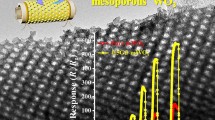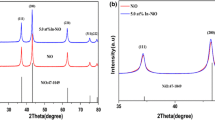Abstract
In this study, a simple and efficient strategy for the construction of hydrangea-like mesoporous WO3 nanoflowers templated using diblock copolymer PS119-PtBA129 was developed. The nanoflower shows good gas sensing properties, especially for 3-hydroxy-2-butanone (3H-2B), which is the signature metabolite of Listeria monocytogenes (L. monocytogenes). Therefore, the gas sensing of 3H-2B by hydrangea-like mesoporous WO3 nanoflowers can be used to detect L. monocytogenes. In the case of 25 ppm 3H-2B as target gas, the response (Ra/Rg) of the hydrangea-like mesoporous WO3 nanoflowers at 205 °C is 152, where Ra and Rg are the resistances of the sensing device in air and target gas, respectively, and the response and recovery times at 25 ppm are 25 s and 146 s, respectively.

Schematic illustration of the formation of hydrangea-like mesoporous WO3 nanoflowers and its gas sensing implication.






Similar content being viewed by others
References
Luo D, Huang XL, Mao Y, Chen CC, Li FL, Xu HY, et al. Two-step large-volume magnetic separation combined with PCR assay for sensitive detection of Listeria monocytogenes in pasteurized milk. J Dairy Sci. 2017;100(10):7883–90. https://doi.org/10.3168/jds.2017-13140.
Aude L, Aymé S, Claudy J, Pascal P, Alain H. Biotic and abiotic soil properties influence survival of Listeria monocytogenes in soil. PLoS One. 2013;8(10):e75969–77. https://doi.org/10.1371/journal.pone.0075969.
Chen R, Huang XL, Xu HY, Xiong YH, Li YB. Plasmonic enzyme-linked immunosorbent assay using nanospherical brushes as a catalase container for colorimetric detection of ultralow concentrations of Listeria monocytogenes. ACS Appl Mater Interfaces. 2015;7(51):28632–9. https://doi.org/10.1021/acsami.5b10181.
Li FL, Li F, Aguilar ZP, Xiong YH, Xu HY. Polyamidoamine (PAMAM) dendrimer-mediated biotin amplified immunomagnetic separation method coupled with flow cytometry for viable Listeria monocytogenes detection. Sensors Actuators B Chem. 2018;257:286–94. https://doi.org/10.1016/j.snb.2017.10.152.
Meng XY, Yang GT, Li FL, Liang TB, Lai WH, Xu HY. Sensitive detection of Staphylococcus aureus with vancomycin conjugated magnetic beads as enrichment carriers combined with flow cytometry. ACS Appl Mater Interfaces. 2017;9(25):21464–72. https://doi.org/10.1021/acsami.7b05479.
Huang XL, Xu ZD, Mao Y, Ji YW, Xu HY, Xiong YH, et al. Gold nanoparticle-based dynamic light scattering immunoassay for ultrasensitive detection of Listeria monocytogenes in lettuces. Biosens Bioelectron. 2015;66:184–90. https://doi.org/10.1016/j.bios.2014.11.016.
Mao Y, Huang XL, Xiong SC, Xu HY, Aguilar ZP, Xiong YH. Large-volume immunomagnetic separation combined with multiplex PCR assay for simultaneous detection of Listeria monocytogenes and Listeria ivanovii in lettuce. Food Control. 2016;59:601–8. https://doi.org/10.1016/j.foodcont.2015.06.048.
Meng XY, Li FL, Li F, Xiong YH, Xu HY. Vancomycin modified PEGylated-magnetic nanoparticles combined with PCR for efficient enrichment and detection of Listeria monocytogenes. Sensors Actuators B Chem. 2017;247:546–55. https://doi.org/10.1016/j.snb.2017.03.079.
Wang D, Wan KC, Zhang M, Li HJ, Wang P, Wang XY, et al. Constructing hierarchical SnO2 nanofiber/nanosheets for efficient formaldehyde detection. Sensors Actuators B Chem. 2019;283:714–23. https://doi.org/10.1016/j.snb.2018.11.125.
Xiao XY, Liu LL, Ma JH, Ren Y, Cheng XW, Zhu YH, et al. Ordered mesoporous tin oxide semiconductors with large pores and crystallized walls for high-performance gas sensing. ACS Appl Mater Interfaces. 2018;10(2):1871–80. https://doi.org/10.1021/acsami.7b18830.
Zhou XR, Zou YD, Ma JH, Cheng XW, Li YY, Deng YH, et al. Cementing mesoporous ZnO with silica for controllable and switchable gas sensing selectivity. Chem Mater. 2019;31:8112–20. https://doi.org/10.1021/acs.chemmater.9b02844.
Wan KC, Wang D, Wang F, Li HJ, Xu JC, Wang XY, et al. Hierarchical In2O3@S-nO2 core–shell nanofiber for high efficiency formaldehyde detection. ACS Appl Mater Interfaces. 2019;11:45214–25. https://doi.org/10.1021/acsami.9b16599.
Ma JH, Ren Y, Zhou XR, Liu LL, Zhu YH, Cheng XW, et al. Pt nanoparticles sensitized ordered mesoporous WO3 semiconductor: gas sensing performance and mechanism study. Adv Funct Mater. 2018;28(6):1705268. https://doi.org/10.1002/adfm.201705268.
Zhu YH, Zhao Y, Ma JH, Cheng XW, Xie J, Xu PC, et al. Mesoporous tungsten oxides with crystalline framework for highly sensitive and selective detection of foodborne pathogens. J Am Chem Soc. 2017;139:10365–73. https://doi.org/10.1021/jacs.7b04221.
Audrain B, Farag M, Ryu CM, Ghigo JM. Role of bacterial volatile compounds in bacterial biology. FEMS Microbiol Rev. 2015;39:222–33. https://doi.org/10.1093/femsre/fuu013.
Schulz S, Dickschat JS. Bacterial volatiles: the smell of small organisms. Nat Prod Rep. 2007;24:814–42.
Ryu CM, Farag MA, Hu CH, Reddy MS. Bacterial volatiles promote growth in Arabidopsis. Proc Natl Acad Sci USA. 2003;100:4927–32.
Wang D, Deng LF, Cai HJ, Yang JL, Bao LP, Zhu YH, et al. Bimetallic PtCu nanocrystal sensitization WO3 hollow spheres for highly efficient 3-hydroxy-2-butanone biomarker detection. ACS Appl Mater Interfaces. 2020;12:18904–12. https://doi.org/10.1021/acsami.0c02523.
Zhu ZY, Zheng LJ, Zheng SZ, Chen J, Liang MH, Tian YT, et al. Cr doped WO3 nanofibers enriched with surface oxygen vacancies for highly sensitive detection of the 3-hydroxy-2-butanone biomarker. J Mater Chem A. 2018;6:21419–27. https://doi.org/10.1039/C8TA08670B.
Chen J, Zhu ZY, Zheng SZ, Du LL, Xing XX, Feng DL, et al. Synthesis of zinc oxide-alumina nanocables for detection of 3-hydroxy-2-butanone biomarker. Mater Lett. 2019;253:121–3. https://doi.org/10.1016/j.matlet.2019.06.044.
Xing XX, Zhu ZY, Du LL, Feng DL, Chen J, Li S, et al. Burrs-shelled SnO2@Al2O3 nanocables for detection of 3-hydroxy-2-butanone biomarkers. Appl Surf Sci. 2020;502:144106–13. https://doi.org/10.1016/j.apsusc.2019.144106.
Cai HJ, Liu HQ, Ni TJ, Pan YJ, Zhao Y, Zhu YH. Controlled synthesis of Pt doped SnO2 mesoporous hollow nanospheres for highly selective and rapidly detection of 3-hydroxy-2-butanone biomarker. Front Chem. 2019;7:843–56. https://doi.org/10.3389/fchem.2019.00843.
Zhu ZY, Zheng LJ, Zheng SZ, Chen J, Xing XX, Feng DL, et al. Multichannel pathway-enriched mesoporous NiO nanocuboids for the highly sensitive and selective detection of 3-hydroxy-2-butanone biomarkers. J Mater Chem A. 2019;7:10456–63. https://doi.org/10.1039/C9TA01013K.
Ren Y, Zou YD, Liu Y, Zhou XR, Ma JH, Zhao DY, et al. Synthesis of orthogonally assembled 3D cross-stacked metal oxide semiconducting nanowires. Nat Mater. 2019;19:203–11. https://doi.org/10.1038/s41563-019-0542-x.
Li YH, Luo W, Qin N, Dong JP, Wei J, Li W, et al. Highly ordered mesoporous tungsten oxides with a large pore size and crystalline framework for H2S sensing. Angew Chem Int Edit. 2014;53(34):9035–40. https://doi.org/10.1002/anie.201403817.
Ren Y, Zhou XR, Luo W, Xu PC, Zhu YH, Li XX, et al. Amphiphilic block copolymer templated synthesis of mesoporous indium oxides with nanosheet-assembled pore walls. Chem Mater. 2016;28(21):7997–8005. https://doi.org/10.1021/acs.chemmater.6b03733.
Xu DP, Yao Y, Han L, Che SA. Molecular design of the amphiphilic AB diblock copolymer toward one-step synthesis of amino-group functionalized large pore mesoporous silica. RCS Adv. 2014;4(81):43047–51. https://doi.org/10.1039/C4RA05790B.
Funding
This work was supported by the National Key R&D Program of China (2018YFC1602500).
Author information
Authors and Affiliations
Contributions
All authors approved the final version of the manuscript.
Corresponding author
Ethics declarations
Conflict of interest
The authors declare that they have no conflict of interest.
Ethics approval
The research followed the tenets of the Declaration of Helsinki.
Additional information
Publisher’s note
Springer Nature remains neutral with regard to jurisdictional claims in published maps and institutional affiliations.
Electronic supplementary material
ESM 1
(PDF 174 kb)
Rights and permissions
About this article
Cite this article
Xu, D., Ge, K., Qi, S. et al. Hydrangea-like mesoporous WO3 nanoflowers with crystalline framework for 3-hydroxy-2-butanone sensing. Anal Bioanal Chem 412, 8371–8378 (2020). https://doi.org/10.1007/s00216-020-02973-2
Received:
Revised:
Accepted:
Published:
Issue Date:
DOI: https://doi.org/10.1007/s00216-020-02973-2




